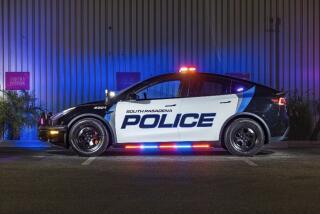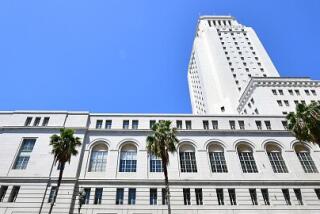Traffic Signals Get a Better Green Light
- Share via
The energy crisis couldn’t do it. It’s taking something called indium gallium nitride to give Los Angeles-area motorists the green light for conservation.
That’s the tongue-twisting name of the material that is finally letting engineers retrofit traffic signals throughout Southern California with electricity-saving light-emitting diode lamps.
Use of LED lamps instead of common incandescent bulbs cuts power consumption about 80% in traffic signals, potentially saving cities millions of dollars a year. The devices also last at least 10 times as long as common bulbs.
The technology to produce red LEDs used in stoplights has been around for more than a decade. But until now an energy-efficient green light for the “go” signal has eluded engineers.
Unlike old-fashioned filament bulbs that take their hue from colored lenses, LEDs are semiconductor chips that produce their own color from what physicists call spectral wavelengths. Instead of one bulb, LED traffic signals contain about 200 pencil-eraser-size points of light.
In the past, the light from green LEDs was too faint to use in traffic signals. But now, new green LEDs made with indium gallium nitride are actually brighter than regular bulbs.
Motorists seem to like the new lights.
“They stand out more,” said Eddie Vardanian, a Hollywood courier who spends nine hours a day behind the wheel.
Added Elva Thirdgill, who has driven one of Santa Monica’s Big Blue Buses for 18 years: “They are a lot easier to see. They certainly help out people with questionable eyesight.”
David Roth, traffic operations superintendent for Santa Monica, said: “We’ve actually gotten a complaint that the new green lights are too bright.” Santa Monica has just finished retrofitting all of its red and green traffic lights.
The old signal lamps used 135-watt incandescent bulbs that lasted about a year. The new LEDs run on 17 watts and have a 10- to 15-year life expectancy.
Santa Monica has retrofitted 3,590 signals. Like most cities, it didn’t include the yellow traffic lights in the changeover because those bulbs are used just three or four seconds at a time. Red and green lights stay on about 30 seconds per cycle.
LED traffic lamps cost about $65 each, though experts expect the price to drop dramatically as they come into wider use. In contrast, the old-style bulbs cost about $2.50 apiece. Roth said virtually all of Santa Monica’s retrofitting costs were covered by a Southern California Edison Co. grant. The city’s power savings are estimated at $91,000 a year.
Such reduced costs--coupled with those from the labor of having to replace burned-out bulbs on an almost annual basis--are making LEDs attractive to local traffic engineers.
In two weeks, West Hollywood plans to begin converting signals at all 50 of its intersections to LED lights. The $260,000 project will pay for 1,666 lamps: pedestrian signals, all red and green lights and a few yellow signals. An $88,000 Edison grant and federal funding will pay for most of the project.
“We’ll probably save $100,000 a year in energy costs,” predicted Eric Millsap, West Hollywood’s traffic engineering technician.
The California Department of Transportation, meantime, has begun converting signals at 850 intersections in Los Angeles and Ventura counties. The $4-million LED project is being financed by Caltrans’ maintenance budget.
Intersections and freeway ramp meter lights are also being targeted, said Judy Gish, a Caltrans spokeswoman. Initially, red LED lights will be installed, and greens and yellows will follow eventually.
“It’s expected they’ll easily pay for themselves with energy savings in five years,” she said.
Some cities didn’t wait for new green-light technology before plugging in LEDs. Anaheim converted 3,753 red signals at 273 intersections two years ago, saving about $214,000 a year, officials said.
Sprawling Los Angeles could save as much as $6 million a year if it converted all 76,000 of its traffic signals, experts say. But a wholesale conversion would require 205,000 LED lamp modules. At current LED prices that would cost $64 million.
So Los Angeles is easing slowly into the world of traffic light diodes. It is launching a campaign to replace about half of the city’s 30,000 “Walk--Don’t Walk” pedestrian signals--called “ped heads” by engineers.
After that, the city plans to retrofit three intersections as a test of the newest LED technology: 1st and Hope streets and 1st and Main streets downtown, and San Fernando Road and Van Nuys Boulevard in the San Fernando Valley.
The city experimented with earlier versions of the technology twice in the last decade, but found that LED lights dimmed more quickly than expected, said John E. Fisher, assistant general manager of operations for the city Department of Transportation.
City traffic engineers are looking forward to yet another innovation for traffic signals: use of a direct current so signals can operate on solar power, Fisher said.
For now, though, development of the bright green LED lamps “is a major breakthrough,” said Ray Deese, an LED pioneer who is president of Corona-based Electro-Tech’s. With 38 years of experience with LEDs, Deese has installed traffic signals around the world. He says he produced the first red LED traffic signal in the United States 12 years ago.
“It was a novelty item back then. I was by myself for a while,” he said.
He concedes that early LEDs were sometimes unreliable. Deese said motorists were sometimes confused by red lights that looked “clear” when their cycle was over or when drivers’ sunglasses altered the color of the LEDs. Engineers began installing red covers over the LED stop lights so they looked normal. Sunglass makers also stopped using certain color-blocking lens formulas, he said.
“I knew it would take time,” said Deese, whose conversations are sprinkled with references to “capacity-reactive circuits,” “total harmonic distortion” and “.9 power factors.”
“You don’t change City Hall overnight,” he said. “If they make a decision to try something new and it doesn’t work, you get into trouble. But the power crisis has ratcheted up things quickly.”
More to Read
Sign up for Essential California
The most important California stories and recommendations in your inbox every morning.
You may occasionally receive promotional content from the Los Angeles Times.














